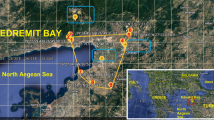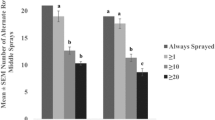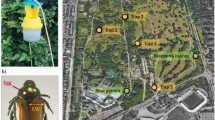Abstract
This study reports a model that utilizes pheromone trap catches to assess the fruit damage caused by Carposina sasakii. The model consisted of four steps: (1) obtaining influx population density using pheromone traps, (2) estimating the actual female population within a defined area using an estimated conversion rate, (3) calculating the total number of eggs using the oviposition model of C. sasakii, and (4) estimating the proportion of fruits infested with eggs (potential damaged fruits) using the relationship between mean egg density per fruit and the proportion of fruits infested with eggs. The relationship between mean egg density (\( \bar{x} \)) per fruit and variance (s 2) was well described by Taylor’s power law, and its parameters were successfully incorporated into the equation that estimates the relationship between mean egg density and the proportion of fruits infested with eggs. In peach orchards, the model accurately predicted the proportion of fruits infested with eggs at the beginning of C. sasakii emergence in early season, but overestimated it in the mid-season. The fitting ability of the model outputs largely increased when the factor of oviposition behavior of C. sasakii was incorporated into the simulation processes, applying the allocation module of total eggs between peaches and apples.





Similar content being viewed by others
References
Anshelevich L, Kehat M, Dunkelblum E, Greenberg S (1993) Sex pheromone traps for monitoring the honeydew moth, Cryptoblabes gnidiella: effect of pheromone components, pheromone dose, field aging of dispenser, and type of trap on male captures. Phytoparasitica 21:189–198
Boo KS (1998) Variation in sex pheromone composition of a few selected lepidopteran species. J Asia Pac Entomol 1:17–23
Boo KS (2001) Development of strategies for monitoring and control of lepidopteran apple insect pests with their sex pheromones. Final report for Technology Development Program of the Ministry of Agriculture and Forestry (1996–2001), Republic of Korea, Seoul, 231 pp (in Korean with an English abstract)
Choi KH, Lee SW, Lee DH, Kim DA, Kim SK (2008) Recent occurrence status of two major fruit moths, oriental fruit moth and peach fruit moth in apple orchards. Korean J Appl Entomol 47:17–22 (in Korean with an English abstract)
Choi KS, Lee JM, Park JH, Cho JR, Song JH, Kim D-S, Boo KS (2009a) Sex pheromone composition of the cotton caterpillar, Palpita indica (Lepidoptera: Pyralidae), in Korea. J Asia Pac Entomol 12:269–275
Choi KS, Cho JR, Song JH, Kim D-S, Boo KS (2009b) Sex pheromone composition of the variegated cutworm, Peridroma saucia (Lepidoptera: Noctuidae), in Korea. J Asia Pac Entomol 12:71–77
Evenden ML, Borden JH, Van Sickle GA, Gries G (1995) Development of a pheromone-based monitoring system for western hemlock looper (Lepidoptera: Geometridae): effect of pheromone dose, lure age, and trap type. Environ Entomol 24:923–932
Han KS, Jung JK, Choi KH, Lee SW, Boo KS (2000) Sex pheromone composition and male trapping of the peach fruit moth, Carposina sasakii (Lepidoptera: Carposinidae) in Korea. J Asia Pac Entomol 3:83–88
Ishiguri Y, Toyoshima S (2006) Larval survival and development of the peach fruit moth, Carposina sasakii (Lepidoptera: Carposinidae), in picked and unpicked apple fruits. Appl Entomol Zool 41:685–690
Jandel Scientific (1996) TableCurve 2D. Automated curve fitting and equation discovery: version 4.0. Jandel scientific, San Rafael
Kim D-S, Lee L-H (2002) Egg and larval survivorship of Carposina sasakii (Lepidoptera: Carposinidae) in apple and peach and their effects on adult population dynamics in orchards. Environ Entomol 31:686–692
Kim D-S, Lee L-H (2003) Oviposition model of Carposina sasakii (Lepidoptera: Carposinidae). Ecol Model 162:145–153
Kim D-S, Lee L-H (2010) A population model for the peach fruit moth, Carposina sasakii Matsumura (Lepidoptera: Carposinidae), in a Korean orchard system. Ecol Model 221:268–280
Kim SB, Yiem MS (1981) Studies on the control and ecology of peach fruit moth (Carposina niponensis Walsingham). Res Rept RDA(H) 23:56–61 (in Korean with an English abstract)
Kim D-S, Lee J-H, Yiem M-S (2000) Spring emergence pattern of Carposina sasakii (Lepidoptera: Carposinidae) in apple orchards in Korea and its forecasting models based on degree-days. Environ Entomol 29:1188–1198
Kim D-S, Lee J-H, Yiem M-S (2001) Temperature-dependent development of Carposina sasakii (Lepidoptera: Carposinidae), and its stage emergence models. Environ Entomol 30:298–305
Kim D-S, Yiem MS, Boo KS, Cho MR, Yang CY, Jeon HY (2003) Effects of pheromone dose, lure age and male-released distance on capture of peach fruit moth, Carposina sasakii (Lepidoptera: Carposinidae). Korean J Int Agric 15:119–128
Knight AL, Croft BA (1987) Regional population dynamics and seasonal spatial patterns of Argyrotaenia citrana (Lepidoptera: Tortricidae) as measured by a pheromone trap grid and larva sampling. Environ Entomol 16:59–67
Knutson AE, Harris MK, Millar JG (1998) Effects of pheromone dose, lure age, and trap design on capture of male pecan nut casebearer (Lepidoptera: Pyralidae) in pheromone-baited traps. J Econ Entomol 91:715–722
Lee SW, Hyun JS, Park JS (1984) Studies on the developments of the overwintering peach fruit moth, Carposina niponensis Walsingham. Korean J Plant Prot 23:42–48 (in Korean with an English abstract)
Miyashita K, Ikeuchi S, Kawamura E (1965) Studies on the seasonal prevalence of the peach fruit moth, Carposina niponensis Walsingham, and chemical control experiment. Hokkaido Agr. Expt. Stn., Rpt., No. 68, 92 pp (in Japanese with English summary)
Narita H, Otake A (1979) Peach fruit moth, Casprisina niponensis Walsingham (Lepidoptera: Carposinidae): biomass and control measures. Rev Plant Proc Res 12:40–63
Pedigo LP, Hutchins SH, Higley LG (1986) Economic injury levels in theory and practice. Annu Rev Entomol 31:341–368
RDA (2001) Income analysis of agricultural products and livestocks. Research Report for Farm Management. RDA, Suwon. http://www2.rda.go.kr/stdinincom
Shaffer PL, Gold HJ (1985) A simulation model of population dynamics of the codling moth, Cydia pomonella. Ecol Model 30:247–274
Taylor LR (1961) Aggregation, variance and the mean. Nature 189:732–735
Tung T, Liu PO, Hwang K (1964) Studies on the biomass and control of the apple fruit borer, Carposina niponensis Walsingham, on Chinese date. Acta Phytophyl Stn 3:361–370 (in Chinese with English summary)
Wilson LT, Room PM (1983) Clumping patterns of fruit and arthropods in cotton with implications for binomial sampling. Environ Entomol 12:50–54
Acknowledgments
This study was partially supported by the National Horticultural Research Institute, RDA.
Author information
Authors and Affiliations
Corresponding author
Appendices
Appendix 1
Equations used in the C. sasakii model. The same parameter symbols used in different equations may have different meanings and values depending on the corresponding equations (see Table 1 for the meaning of symbols).
Simple exponential equation
Modified logistic function
Taylor’s mean-variance model
Wilson and Room’s model
The parameters of a and b are taken from Taylor’s model.
Appendix 2
See Table 4.
Rights and permissions
About this article
Cite this article
Kim, DS., Lee, JH. A novel approach to the assessment of fruit damage caused by Carposina sasakii (Lepidoptera: Carposinidae) using pheromone trap catches in Korean orchards. Appl Entomol Zool 46, 143–152 (2011). https://doi.org/10.1007/s13355-010-0022-x
Received:
Accepted:
Published:
Issue Date:
DOI: https://doi.org/10.1007/s13355-010-0022-x




